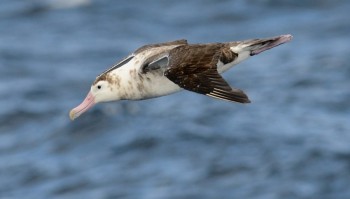
A dark-winged Amsterdam Albatross off Amsterdam Island, photograph by Kirk Zufelt
Svana Rogalla (Evolution and Optics of Nanostructures Group, Department of Biology, University of Ghent, Belgium) and colleagues have published in the Journal of the Royal Society Interface on a phylogenetic analysis and wind tunnel experiments to show that the dark wings of seabirds (including those of albatrosses and petrels) improve flight efficiency when undergoing radiative heating.
The paper’s abstract follows:
"Seabirds have evolved numerous adaptations that allow them to thrive under hostile conditions. Many seabirds share similar colour patterns, often with dark wings, suggesting that their coloration might be adaptive. Interestingly, these darker wings become hotter when birds fly under high solar irradiance, and previous studies on aerofoils have provided evidence that aerofoil surface heating can affect the ratio between lift and drag, i.e. flight efficiency. However, whether this effect benefits birds remains unknown. Here, we first used phylogenetic analyses to show that strictly oceanic seabirds with a higher glide performance (optimized by reduced sink rates, i.e. the altitude lost over time) have evolved darker wings, potentially as an additional adaptation to improve flight. Using wind tunnel experiments, we then showed that radiative heating of bird wings indeed improves their flight efficiency. These results illustrate that seabirds may have evolved wing pigmentation in part through selection for flight performance under extreme ocean conditions. We suggest that other bird clades, particularly long-distance migrants, might also benefit from this effect and therefore might show similar evolutionary trajectories. These findings may also serve as a guide for bioinspired innovations in aerospace and aviation, especially in low-speed regimes.”
Read an interview with the senior author of the study here.
With thanks to Janine Dunlop, Niven Librarian, FitzPatrick Institute of African Ornithology, University of Cape Town.
Reference:
Rogalla, S., Nicolaï, M.P.J., Porchetta, S., Glabeke, G., Battistella, C., D'Alba, L., Gianneschi, N.C., van Beeck, J. & Shawkey, N.D. 2021. The evolution of darker wings in seabirds in relation to temperature-dependent flight efficiency. Journal of the Royal Society Interface doi.org/10.1098/rsif.2021.0236.
John Cooper, ACAP Information Officer, 21 July 2021

 Español
Español  English
English  Français
Français